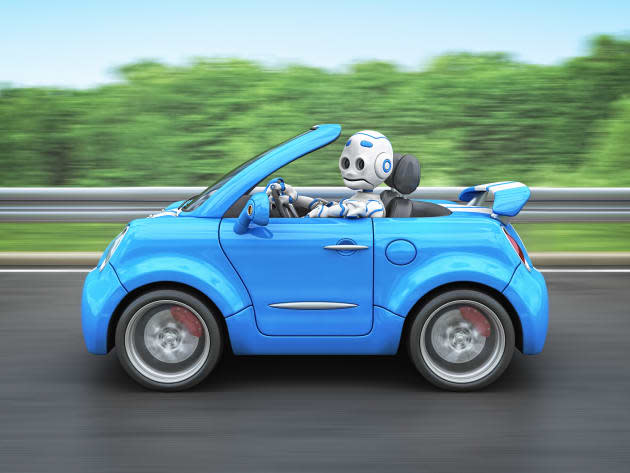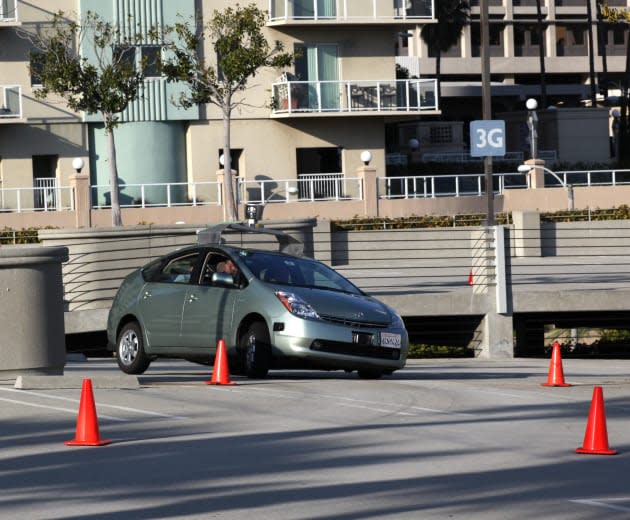What you need to know about self-driving cars

A few months back at CES, I found myself at the Las Vegas Motor Speedway as a guest at BMW's "Highly Autonomous Driving" demo. While our cameraman set up his gear and I pondered what I was going to say about BMW's mystery kit, I watched one of the carmaker's drivers hooning through a wet section of the track drifting an M235i. Little did I know at the time that the driver wasn't actually driving: He was a passenger. That night, BMW suggested self-driving cars were years off, maybe as many as 10. But Google's just shown us its vision, and the "when" is much, much closer. Despite my racing-heavy introduction earlier this year, the automakers want to sell self-driving cars as a safety blanket. And if they can prove its ability to save lives, it'll become a reality in short order.
WHAT IS IT?

Call the technology what you will: driverless, highly autonomous or self-driving. No matter the term used, the end result is that some element of control of the vehicle passes from your hands and feet to a computer. In its simplest form, cruise control could be considered part of this technology, though traditionally it is referred to as a driving aid. As one of its seemingly endless list of features, Audi offers Adaptive Cruise Control with Stop & Go in some of its fleet. This technology enables your car to follow the vehicle ahead of you in traffic, automatically speeding up and braking when they do and even coming to a complete stop if needed. These driver-assist tools attempt to take the drudgery out of driving, leaving you to enjoy the rest. Driving automation is about improving the experience and adding safety.
But what's being proposed recently by the likes of Google, Audi, Volvo, BMW and most other large automakers is much, much more. This discussion is not about automated aids, but about complete control of the driving experience. Google's newly announced car, for example, completely computerizes all the work of driving and replaces all pilot input with a start and stop button. You won't need to know how to drive. In fact, you don't even have to care about cars anymore if you'd rather not. Google's vision happens to be a pod you travel in as if by magic; other makers may opt to have control available that you can enable or disable.
BMW's demos in Vegas showed off what its cars can do without any human interaction at the "dynamic limits of the car." In short, we blitzed about a track at close to 70MPH in a twisty section, through pylons in an Auto-X demonstration and then capped it with some emergency avoidance maneuvers. It was our first time going for a drive without a person actually being involved in the process and we left fairly awestruck. At the very end of our test session, the M235i intentionally drifted by loading on the power going into a wet bend and the car maintained the slide by itself. The demonstration was very impressive, made more so by the fact we weren't just toddling down the street on a milk run: We were hustling.
That said, we also saw that same car get it completely wrong in the wet section and spin out, so it's not infallible.
HOW DOES IT WORK?
Google's car is outfitted with a staggering array of equipment to keep tabs on where it is and to track its surroundings. A LiDAR (Light Detection and Ranging) scanner on the car's roof maps the world in real time, similar to Microsoft's Kinect. It tracks depth and distance, acting as the car's eyes. That info is compared to stored data to help discern pedestrians from inanimate objects.
In tandem, radar and ultrasonic scanners (plus cameras) keep track of the 360 degrees of space around the car. This includes reading signage, watching for road hazards, monitoring for red lights and everything else you normally watch out for while driving. Google has been adding scenarios for road hazards such as construction and even recognizing and understanding a cyclist's hand signals for lane changes and the like. Think of this system as the car's brain.
Google may be at the forefront of this new frontier of automobiles, but the company will likely remain behind the scenes in the industry. While we don't see Google selling cars, we do expect it will stay an innovator in the space, developing the platform for car vendors. Like how its Android OS is adopted by cellphone makers, it's not hard to imagine the same happening for automotive tech.
WHY SHOULD I CARE?
Where you stand on this likely depends on what you hope to get out of your automated driving experience. If you can't parallel park to save your life -– or other's bumpers -– BMW's i3 can already take care of that for you. Maybe you're worried about pop as he's older and no longer safe driving for his groceries? No worries: Type in a destination and the car will get him there.
Or perhaps you don't own a car or live in an area with no parking? Car-sharing services will undoubtedly become more popular and simpler to use. Imagine reserving your ride in an app and having the car arrive at your doorstep at some predetermined time. You arrive at your destination, hop out and then the car takes off on some other mission like a taxi, but with no driver or fare. Once you've wrapped up your business, your car is there, on time for the scheduled pickup. People with impaired vision, problems with mobility or other ailments that prevent them from driving a car will have another transportation option. Being able to arrange your own travel to and from where you're going on any particular day without need for any other party's taxi, bus or shuttle is a revelation. Party people will celebrate having another way to get home after drinking more glasses of wine than planned. Hop in your car and have it ferry you home, safely.
Of course, traditional methods of carriage for the drunken may not cheer this new technology. Uber (and its ilk), taxis and even buses/subways could see a slip in customers as these new choices come online. Also consider the downsides: Instead of parking your car once you arrive at your destination, it simply heads home, using more energy. While these technologies buoy ease of use and safety, they do little to directly reduce the number of cars on the road.
WHAT'S THE ARGUMENT?

Some folks are going to hate it, plain and simple. Having no control of the metal box carting you through space at high speed is likely to be an intimidating experience for some. So much happens around you while you're driving: What if the car doesn't react properly? Or at all? What if the system crashes? All of these are valid concerns, and all are possible. To the credit of interested parties, years of work have gone into this research by many companies. Google alone has logged 700,000 autonomous miles of driving. That's almost two round-trips to the moon, or nearly 30 laps around our little blue planet.
The National Safety Council estimates that roughly 35,000 people died in 2013 in US traffic accidents. There were also some 3.8 million car crashes requiring medical attention. The NSC also estimates that hundreds of billions of dollars per year are spent on crashes if you tally up lost revenue, insurance payouts, medical costs and property damage.
People make mistakes. We're easily distracted and we certainly can't juggle 20 tasks at once while driving. Computers can; they never tire, never get sleepy or spill a latte on their lap while fumbling for a turn indicator.
WHAT DOES THE LAW SAY?

The laws surrounding driverless cars are shiny new. With only California, Nevada, Michigan, Florida and the District of Columbia offering the thumbs up thus far, there's definitely a long road ahead. Currently those states require a driver behind the wheel just in case something goes awry. Technical issues aside, the legality of it all may be its biggest initial stumbling block to success. Meanwhile, the statistical argument in favor of self-driving cars is pretty strong: 90 percent of accidents are human error.
Also consider that as most state legislation doesn't outright prohibit -– or even consider the possibility -- of automated cars, the question of liability will need to be addressed. Who will be held "at fault" in the case of an accident? The carmaker? The software integrator? A sensor manufacturer? In the case of human driver vs. machine driver, the tapes could be reviewed as the automated car would have recorded footage leading up to the accident to help demonstrate where guilt should be attached. It's a whole new legal realm we've barely explored.
WANT TO KNOW MORE?
If you want to keep abreast of what Google's up to with its cute-as-a-button automatic car, just track this site. If you happen to live in Michigan, one of your universities is set to become a hotbed for automotive study. Take a peek at the University of Michigan's Mobility Transformation Facility and the whopping 32-acre test facility being built right now. If you're curious about the i3 and all its magical tech, BMW gives away some more technical info over here. Lastly, Audi's list of driving aids is miles long and some are pretty nifty; have a gander at those here.
[Image credit: Google, jurvetson/Flickr, Si-MOCs/Flickr]

